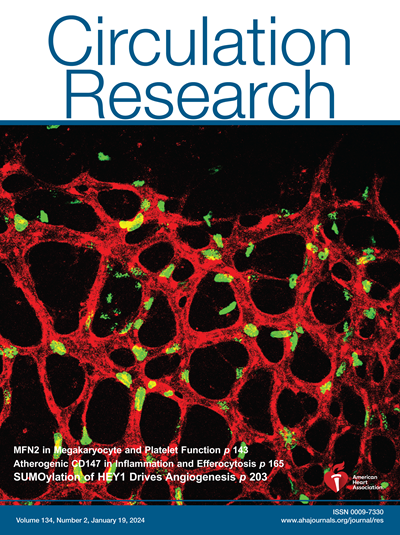Dysregulated Protein s-Nitrosylation Promotes Nitrosative Stress and Disease Progression in Heart Failure With Preserved Ejection Fraction.
IF 16.2
1区 医学
Q1 CARDIAC & CARDIOVASCULAR SYSTEMS
引用次数: 0
Abstract
BACKGROUND Recent studies suggest aberrant elevation of iNOS (inducible NO synthase) expression and excessive protein s-nitrosylation promote the pathogenesis of heart failure with preserved ejection fraction (HFpEF). However, the interplay between NO bioavailability, enzymatic regulation of protein s-nitrosylation by transnitrosylase and denitrosylase, and HFpEF progression remains poorly defined. We investigated the molecular basis of nitrosative stress in HFpEF, focusing on alterations in NO signaling and regulation of protein s-nitrosylation. METHODS Circulating nitrite (NO bioavailability) and nitrosothiols were quantified in patients with HFpEF. Parallel studies using rodent models of cardiometabolic HFpEF were performed to evaluate cardiac function, NO signaling, and total nitroso species during disease progression. Single-nucleus RNA sequencing and proteomic analysis were conducted to identify regulatory genes and cellular targets of pathological s-nitrosylation. RESULTS In patients with HFpEF, circulating nitrosothiols were significantly elevated, indicating heightened nitrosative stress, whereas nitrite levels remained unchanged. In Zucker fatty obese rats, NO bioavailability declined with age, whereas total nitroso species progressively increased as HFpEF worsened. Transcriptomic analysis revealed marked upregulation of a transnitrosylase HBb (hemoglobin-β subunit), validated in both rat and human HFpEF hearts. Enzymatic assays demonstrated aberrant functions of Trx2 (thioredoxin 2) and GSNOR (S-nitrosoglutathione reductase) in Zucker fatty hearts. Cell-based experiments confirmed that altered expression or function of HBb, Trx2, and GSNOR resulted in elevated cellular RxNO. Additionally, similar dysregulation of s-nitrosylation dynamics was observed in the peripheral organs, such as the kidneys and livers, in HFpEF. CONCLUSIONS These data demonstrate that nitrosative stress, evidenced by dysregulated protein s-nitrosylation occurs in the heart and peripheral organs in cardiometabolic HFpEF. Pathological alterations in NO bioavailability resulting from alterations in NOS expression or function alone do not account for this phenotype. Instead, pathological protein s-nitrosylation results in part from the imbalance between transnitrosylase and denitrosylase function. Restoration of physiological levels of protein s-nitrosylation and NO signaling may represent an effective therapeutic target for HFpEF.蛋白质s-亚硝基化失调促进亚硝化应激和保留射血分数的心力衰竭疾病进展。
最近的研究表明,iNOS(诱导型NO合成酶)表达异常升高和过度的蛋白质s-亚硝基化促进了保留射血分数(HFpEF)心力衰竭的发病机制。然而,一氧化氮的生物利用度、转亚硝基化酶和脱硝基化酶对蛋白质s-亚硝基化的酶调节以及HFpEF进展之间的相互作用仍不明确。我们研究了HFpEF中亚硝化胁迫的分子基础,重点研究了NO信号的改变和蛋白质s-亚硝基化的调节。方法定量测定HFpEF患者体内循环亚硝酸盐(NO生物利用度)和亚硝基硫醇含量。使用心脏代谢HFpEF的啮齿动物模型进行平行研究,以评估疾病进展过程中的心功能、NO信号和总亚硝基物种。通过单核RNA测序和蛋白质组学分析,鉴定病理性s-亚硝基化的调控基因和细胞靶点。结果HFpEF患者循环亚硝基硫醇水平显著升高,表明亚硝酸盐水平不变,而亚硝基硫醇水平升高。在Zucker脂肪肥胖大鼠中,NO的生物利用度随着年龄的增长而下降,而总亚硝基种类随着HFpEF的恶化而逐渐增加。转录组学分析显示,转亚硝基酶HBb(血红蛋白-β亚基)显著上调,这在大鼠和人HFpEF心脏中都得到了证实。酶分析显示Trx2(硫氧还蛋白2)和GSNOR (s -亚硝基谷胱甘肽还原酶)在Zucker脂肪心脏中的异常功能。基于细胞的实验证实,HBb、Trx2和GSNOR的表达或功能改变导致细胞RxNO升高。此外,在HFpEF的外周器官,如肾脏和肝脏,也观察到类似的s-亚硝基化动力学失调。结论这些数据表明,在心脏代谢性HFpEF中,以蛋白质s-亚硝基化失调为证据的亚硝化应激发生在心脏和外周器官。由NOS表达或功能改变引起的NO生物利用度的病理改变不能单独解释这种表型。相反,病理蛋白质s-亚硝基化的部分原因是转亚硝基化酶和脱亚硝基化酶功能的不平衡。恢复生理水平的蛋白质s-亚硝基化和NO信号可能是HFpEF的有效治疗靶点。
本文章由计算机程序翻译,如有差异,请以英文原文为准。
求助全文
约1分钟内获得全文
求助全文
来源期刊

Circulation research
医学-外周血管病
CiteScore
29.60
自引率
2.00%
发文量
535
审稿时长
3-6 weeks
期刊介绍:
Circulation Research is a peer-reviewed journal that serves as a forum for the highest quality research in basic cardiovascular biology. The journal publishes studies that utilize state-of-the-art approaches to investigate mechanisms of human disease, as well as translational and clinical research that provide fundamental insights into the basis of disease and the mechanism of therapies.
Circulation Research has a broad audience that includes clinical and academic cardiologists, basic cardiovascular scientists, physiologists, cellular and molecular biologists, and cardiovascular pharmacologists. The journal aims to advance the understanding of cardiovascular biology and disease by disseminating cutting-edge research to these diverse communities.
In terms of indexing, Circulation Research is included in several prominent scientific databases, including BIOSIS, CAB Abstracts, Chemical Abstracts, Current Contents, EMBASE, and MEDLINE. This ensures that the journal's articles are easily discoverable and accessible to researchers in the field.
Overall, Circulation Research is a reputable publication that attracts high-quality research and provides a platform for the dissemination of important findings in basic cardiovascular biology and its translational and clinical applications.
 求助内容:
求助内容: 应助结果提醒方式:
应助结果提醒方式:


